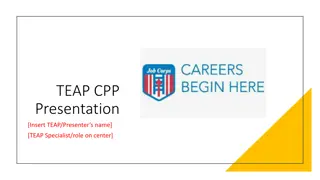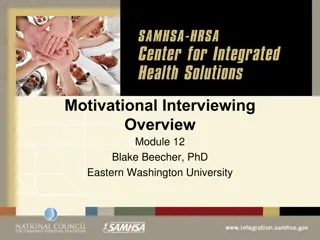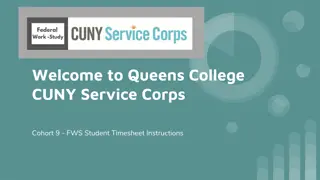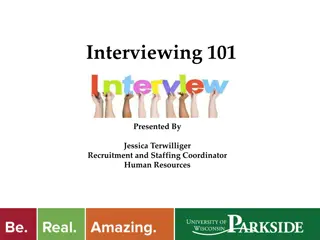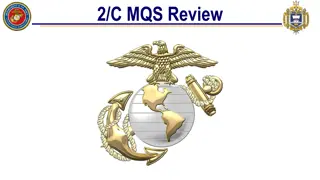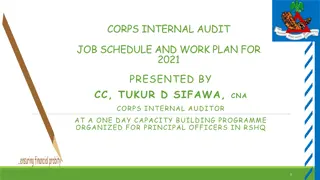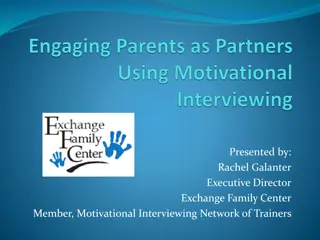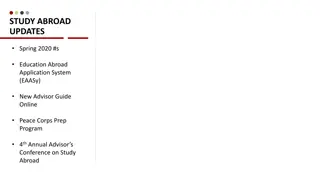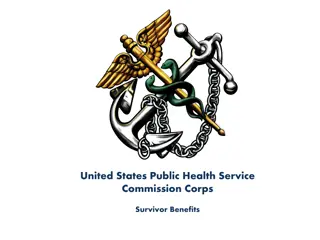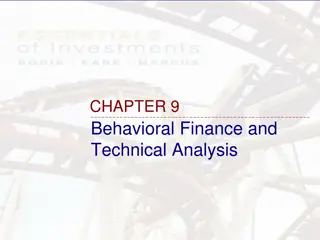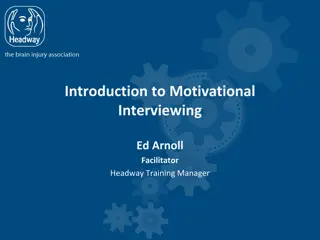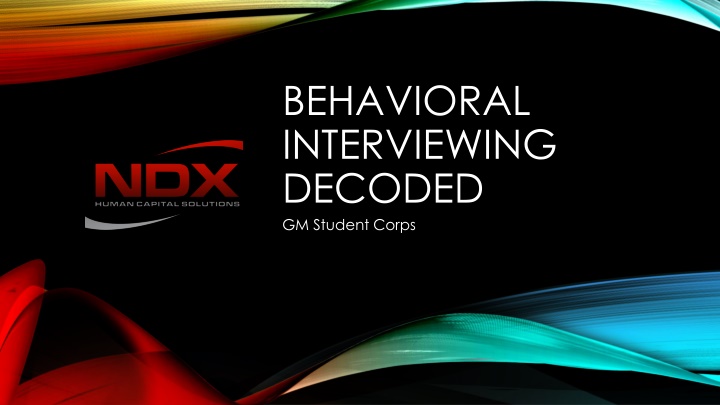
Effective Behavioral Interviewing Techniques: STAR Method Explained
Learn how to master behavioral interviews with the STAR method - Situation, Task, Action, Result. Discover why past performance is crucial, how to structure your answers, and when to apply this technique for success in job interviews.
Download Presentation

Please find below an Image/Link to download the presentation.
The content on the website is provided AS IS for your information and personal use only. It may not be sold, licensed, or shared on other websites without obtaining consent from the author. If you encounter any issues during the download, it is possible that the publisher has removed the file from their server.
You are allowed to download the files provided on this website for personal or commercial use, subject to the condition that they are used lawfully. All files are the property of their respective owners.
The content on the website is provided AS IS for your information and personal use only. It may not be sold, licensed, or shared on other websites without obtaining consent from the author.
E N D
Presentation Transcript
BEHAVIORAL INTERVIEWING DECODED GM Student Corps
BEHAVIORAL INTERVIEWS DECODED
BEHAVIORAL INTERVIEWS DECODED Behavioral interviewingis a style of interviewing that was developed in the 1970 s by industrial psychologists. Behavioral interviewing asserts that the most accurate predictor of future performance is past performance in a similar situation. Behavioral interviewing emphasizes past performance and behaviors. Behavioral interview questions are generally formatted by presenting a situation, inquiring about what action you have taken to respond to something similar in the past, and what the result was. Behavioral interview questions ask you to give specific examples of when you demonstrated behaviors or skills. This helps employers predict how you will succeed in the future.
BEHAVIORAL INTERVIEWS DECODED One particularly effective technique to use for behavioral interview questions is known as the STAR method. Stay with us to learn how you can use the STAR method to shine in your next interview.
STAR METHOD WHAT IS IT? The STAR method is an effective interview technique for answering behavioral (also called competency) interview questions. STAR is an acronym that stands for situation, task, action and result, which are the essential components of an effective answer to behavioral interview questions.
STAR METHOD HOW DOES IT WORK? How does it work? Aims to evaluate the ways that you ve handled past situations, commonly job-related, and tests your thinking and decision-making skills, as to how you re going to handle the same situation if it happens again. In short, a STAR format interview asks one to give a real-life example of how one handled a specific past situation.
STAR METHOD WHEN TO USE IT The STAR method can be used for questions that prompt you to share a story with a point from your past. Each question will typically assess one particular competency or type of behavior. A good indicator of whether the STAR method will work for a particular question is whether the question is in one of the below formats: Tell me about a time Can you provide an example Describe a time Have you ever been in a situation
STAR METHOD SITUATION Provide the background details of the event, experience, or situation. Make sure to not overly generalize but rather be specific Be sure to give enough detail for the interviewer to understand. This situation can be from a previous job, academic project work, or volunteer work to name a few. Just make sure it s relevant. TASK Explain what your responsibilities were in this situation. Provide good examples.
STAR METHOD ACTION Describe how you addressed or accomplished the task. Describe the action you took and be sure to keep the focus on you. Even if you are discussing a group project or effort, describe what you didand your contributions- - not the efforts of the team. Don't tell what you might do, tell what you did. Provide good examples. RESULTS Illustrate the final outcomes of the situation. What happened? How did the event end? What did you accomplish? What did you learn? Provide good examples.
STAR METHOD EXAMPLE QUESTION Tell me about a time when you had too many things to do, and how did you handle this? During my Senior year at MSU, I needed to prepare for two mid-terms but during the same week, the sorority organization I was heavily involved in, Zeta Tau Alpha was hosting a big fundraising event (SITUATION) In order to not get overwhelmed, I needed to multitask but at the same time prioritize the tasks I needed to complete first (TASK) I created a schedule for the busy week ahead and made sure I had sufficient time to study for my mid-terms. Since I had dedicated times to study, I also was able to find time to help plan the final logistics of the fundraising event (ACTION) In the end, I got A s on both mid-terms and we had a large turnout for our fundraiser at the ZTA Walkathon. (RESULT)
HOW TO PREP FOR A BEHAVIORAL INTERVIEW 1. Practice and Prepare You may not have control over what questions you are asked during your behavioral interview, but you do have control over the stories you choose to share. Take the initiative before your interview to come up with several 60- to 90-second stories of experiences that show how you handle problems in the workplace successfully. Think of times when you have overcome stress when you've had to show strong leadership skills, or when you've dealt with a crisis successfully. Come prepared with four or five different stories that highlight your skills that can be adapted to different types of questions.
HOW TO PREP FOR A BEHAVIORAL INTERVIEW 1. Practice and Prepare You may not have control over what questions you are asked during your behavioral interview, but you do have control over the stories you choose to share. Take the initiative before your interview to come up with several 60- to 90-second stories of experiences that show how you handle problems in the workplace successfully. Think of times when you have overcome stress when you've had to show strong leadership skills, or when you've dealt with a crisis successfully. Come prepared with four or five different stories that highlight your skills that can be adapted to different types of questions.
HOW TO PREP FOR A BEHAVIORAL INTERVIEW 2. Research the Company As with a traditional interview, researching the employer is vital during a behavioral interview. Because the questions are more abstract, you'll want to choose examples that fit in with the company values and goals. For example, if the company does a lot of volunteer work in the community, use examples of times when you've volunteered your time to help others. This shows you are committed to the same things the company values.
HOW TO PREP FOR A BEHAVIORAL INTERVIEW 3. Practice the S.T.A.R. Method The S.T.A.R. method is a great way to prepare for behavioral questions in three simple steps. First, explain the Situation or Task you were confronted with. Describe this in reasonable detail, but don't focus on it for too long since this can often be the negative part of the story. Second, talk about the Action you took to resolve the situation. You can take longer to discuss this section, as it truly highlights your critical thinking and creativity. Finally, wrap up the anecdote with the Result, or how things changed after you completed your action. In most situations, you want the result to be good, but even poor results can make good stories if you truly learned from them. Using the S.T.A.R. method allows you to break down your stories into simple, quick examples that highlight your best skills and abilities.
HOW TO PREP FOR A BEHAVIORAL INTERVIEW 4. Study the Job Description When you are coming up with your examples, you don't want to just pull random stories out of the air. Rather, you want to tailor your experiences to the ones that will be most beneficial to the specific job you are applying for. In order to do this, read through the job description and highlight the soft skills needed for the position. Customize your answers to show off these skills and show why you are the best candidate for this particular job. For example, if the job description mentions good communication skills, think of a time when you were faced with a communication problem and how you dealt with it. If the job requires leadership skills, pull from times when you were put in charge of a group of people or project and how you motivated everyone to get it done. The more focused your examples are, the more successful your interview will be.
HOW TO PREP FOR A BEHAVIORAL INTERVIEW 5. Come Prepared Even if you know your resume inside and out, it may change based on the job you are applying for. Always bring a copy of the submitted resume to a job interview, along with a few highlighted notes about what you want to share and questions you want to ask. Keep the notes simple, but having prepared questions shows that you are interested in the company and the job.
STAR TIPS 1. Understand the question In order to answer the question on point you want to make sure you fully comprehend it. If you are not sure of the question being asked you can ask the question back for confirmation or ask the interviewer to repeat themselves.
STAR TIPS 2. Be specific Being detailed and specific in your answers will help to provide your interviewers will a clear picture of the situation and your role in it. If you have figures that could enhance your story, it s a good idea to provide those as well. For example, instead of saying, I increased revenue significantly, you could say, I increased revenue by 10%.
STAR TIPS 3. Focus on your contribution If you re someone who is team-oriented, it can be tempting to use the term we when discussing past work situations. However, the interviewers are interested in the impact that you made. Therefore, particularly when discussing the action and result part of your story, try to focus more on your role as opposed to the actions of the team.
STAR TIPS 4. Use relevant experience Although competency interviews typically assess your behavioral fit for the role, as opposed to your technical fit, it is a good idea to keep your stories as relevant to the role as possible. For example, if you are applying for a job as an entry-level accountant, your volunteer experience as Treasurer for the university club may be more relevant than your customer service experience while working in a clothing store. Try to use examples from your past that are most suited to the job, so the interviewers can really picture you in the role.
STAR TIPS 5. Stay concise A common problem that many job seekers struggle with in interviews is rambling. However, it could be a red flag to the interviewer that you have difficulty with organized and clear thinking. One way to stay on track and concise during your interview is to pause and take a breath before answering. This will give you time to organize your thoughts and put you in a better position to answer more to the point.
STAR TIPS 6. Highlight your achievements Interviews are one of the few social situations where it is okay to brag about your achievements the trick is to not go overboard. You want to ensure that the interviewers are aware of your past accomplishments and talents without coming across as arrogant or overly confident. One way to sell yourself without boasting is to simply state the facts. As opposed to saying, I m an accomplished sales representative, you could say, I consistently overachieve on my targets by 10%. This way, it isn t coming across as bragging, but simply stating the facts.
STAR TIPS 7. Be honest Honesty is always the best policy, particularly in interviews. So, if you are ever asked a question for which you don t have an example, be honest with the interviewer. You could offer to provide another example that displays that competency. For example, I have never come across that situation specifically, but I have another example of a time I displayed problem-solving skills that I could share. The interviewers will always appreciate your honesty.
STAR TIPS 8. Keep it positive People like to work with coworkers that have a positive attitude and disposition. Therefore, while it s important to be honest, you do have the option to leave certain information out if it could put you or your past coworkers in a bad light. It s important to make sure you never speak poorly about any previous coworkers or employers and to keep the tone positive.
STAR TIPS 9. Be relatable Oftentimes, when telling stories, the goal is to entertain or impress. However, in interviews, the goal isn t always to impress, but to show them that you are the right person for the role. Your answers don t have to be perfect. You ll get farther if you show that you are human and that you re the right fit for the job.
COMMON MISTAKES TO AVOID Not preparing for the interview Being unprepared can lead to a lot of rambling when you need to answer even the most common behavioral questions. By coming with behavioral examples prepared it will boost your confidence in the interview and avoid you being taken off guard. Sounding robotic Over preparing can result in sounding rehearsed and unnatural. You can prepare and review your example situations and success stories, but don t over prepare. Otherwise, you ll sound robotic when answering the questions. Be natural and light. You don t have to practice and memorize any script anyway.
COMMON MISTAKES TO AVOID Not preparing for the interview Being unprepared can lead to a lot of rambling when you need to answer even the most common behavioral questions. By coming with behavioral examples prepared it will boost your confidence in the interview and avoid you being taken off guard. Sounding robotic Over preparing can result in sounding rehearsed and unnatural. You can prepare and review your example situations and success stories, but don t over prepare. Otherwise, you ll sound robotic when answering the questions. Be natural and light. You don t have to practice and memorize any script anyway.
COMMON MISTAKES TO AVOID Telling an unrelated story Attention to detail is one of the key attributes of a good prospective employee. You should display your focus and specifically answer the question. Think about one or two specific details to use in your answer that are related to the question. Not being specific Don t be vague with your response. The interviewer wants to hear the specifics of your story. Vagueness weakens your impact. It is why you need to prepare beforehand and practice with the most common interview questions. Before your interview, you should identify your qualities and skills, which the company is also looking for in an ideal candidate. Highlight such behavior that the interviewer is interested in and ensures that your success story matches it.
FINAL THOUGHTS The STAR interview offers you an excellent way of answering behavioral questions in a succinct, concise manner. It can help you show off your skills and abilities in work situations, giving the employer an insight into what a great fit you are for their company and the role you are interviewing for.
Thank you for your time today and good luck to each and every one of you!
EXAMPLES The following slides contain additional Examples of how to successfully answer behavioral questions with the STAR method
CAN YOU GIVE ME AN EXAMPLE OF A TIME YOU TOOK INITIATIVE? Situation: In my previous job as events assistant, I was responsible for managing large conferences. Task: Normally, the conferences were in person, but I was tasked with managing an online event. It was my first time managing an online event and I wanted it to be a success. Action: Therefore, I took the initiative to do extensive research on event software and best practices for virtual event management and compiled my findings in a report. Result: I presented this report to my supervisor, and we were able to make an informed decision about the virtual event. The event went off without a hitch and I was formally recognized for my initiative.
CAN YOU TELL ME ABOUT A TIME YOU HAD A CONFLICT OR DISAGREEMENT WITH A TEAM MEMBER? Situation: While I was working as a project manager in my previous role, I was working on a new software development project with a coworker in my team. Task: We had an important deadline coming up for the project and I noticed that my coworker was falling behind. Therefore, I approached him about it, and he became very defensive and wouldn t give me a clear answer or status update. Action: Even though he didn t seem happy with me approaching him, I knew we wouldn t make the deadline. Therefore, I asked what the issue was and if I could help. He told me he had another project and was over capacity. So, I suggested we go to our supervisor and prioritize the workload to ensure deadlines are met are adjusted accordingly. Result: Our supervisor adjusted the workload, so that we were able to meet our deadline and my colleague was satisfied with the proposed solution. We ended up delivering the project to a high standard.
GIVE ME AN EXAMPLE OF A TIME YOU CREATED A GOAL FOR YOURSELF AND THEN ACHIEVED IT. Situation: At my previous company, I was working as a sales representative and was consistently meeting my targets each quarter. Task: I decided that I wanted to not only meet my targets but set a goal for myself to exceed my targets by 10% in the third quarter. Action: I created a plan where I broke down tasks by week and by day. For example, I would contact a specific number of prospects per day and ensure I was meeting the weekly targets I set for myself. Result: By the third quarter, I exceeded my targets by 20% and had overachieved the goal I had set for myself. My manager was so impressed that I received a promotion to senior sales representative.
What does the S stand for in the STAR method? QUESTION 1 Situation
What does the T stand for in the STAR method? QUESTION 2 Task
What does the A stand for in the STAR method? QUESTION 3 Action
What does the R stand for in the STAR method? QUESTION 4 Result
What are the 3 steps to answering a behavioral interview question utilizing the STAR method? QUESTION 5 1. Explain the Situation or Task you were confronted with 2. Talk about the Action you took to resolve the situation. 3. Wrap up the anecdote with the Result, or how things changed after you completed your action.



